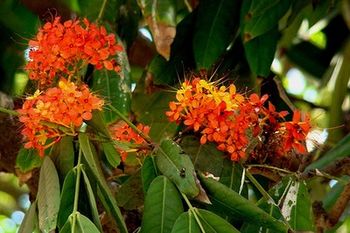Ashoka
Other Names : Saraca asoca, Ashok-goch, Ahok, Ashok, Ashokam, Ashok tree, Ashopalava, Ashok अशोक, सीता अशोक Sita Ashok, Achenge, Mir krem, Hemapushpam, Jasundi, Sorrowless Tree, Sita Ashok, அசோகம் Asogam, Ashoka Tree, Asokamu
Bark of this tree is rich in tannins, flavonoids, steroids, volatile oil, glycosides, and various steroidal glycosides. Leaves contain various carbohydrates, tannins, gallic acid and egallic acid. Flowers are rich in saracasin, saracadin, waxy substances, proteins, carbohydrates and steroids. Seeds of this plant contains various fatty acids like oleic, linoleic, palmitic and stearic acid.
Special Precautions of Ashoka
The name S. indica has been generally incorrectly applied to S. asoca since 1869. It can be distinguished from S. asoca by its non-clasping bracteoles, a lower number of ovules, slightly smaller pods, and a more eastern geographic distribution
Health Benefits and Uses of Ashoka
The plant is found to have spasmogenic, oxytocic, uterotonic, antibacterial, anti-implantation, antitumor, antiprogestational, antioestrogenic activity
- Ashoka bark is bitter, acrid, refrigerant, astringent to the bowels, cures dyspepsia, enlargement of the abdomen, piles and ulcers (Kirtikar & Basu 1975). Bark is useful in menorrhagia due to uterine fibroids, in internal bleeding hemorrhoids and hemorrhagic dysentery (Nadkarni 1982). Leaves have blood purifying properties and their juice mixed with cumin seeds is used for stomach-ache. Flowers of S. asoca are considered to be uterine tonic and used in dysentery, scabies, syphilis, burning sensation and in hemorrhoids. Dried flowers are used in diabetes.
- Seeds are used for treating bone fractures and vesical calculi (Warrier et al. 1997).
- Pharmacologically the plant have been reported to possess, antibacterial (Acharyya et al. 2009), analgesic (Verma et al. 2010, Mohod et al. 2014), anticancer (Kaur & Misra 1980, Ghosh et al. 1999, Cibin et al. 2012), antiulcer (Maruthappan et al. 2010), oxytocic (Satyavati et al. 1970), anti-inflammatory (Shelar et al. 2010), anthelmintic (Sarojini et al. 2011) and larvicidal activity (Mathew et al. 2009).
- Reported phytoconstituents from S. asoca bark are catechin,epicatechin, procyanidin B2, leucocyanidin and epiafzelechin-(4β→8)-epicatechin.
- Leaves contain quercetin, β-sitosterol, gallic acid and ellagic acid. Flowers contained oleic, palmitic, linoleic acid, quercetin, gallic acid and ellagic acid.
- Seeds have been reported to contain various fatty acids such as oleic, linoleic, palmitic and stearic acid (Chatterjee & Pakrashi 2006). The most important and widely used part of the ashoka plant is its bark, flowers are another important ingredients in many ashoka herbal formulations
- Ashoka has cooling properties. It is very useful for the body to bring down excessive heat in the organs due to fatigue or hormonal imbalance. This herb helps to regulate blood composition and stabilize blood circulation making it optimally available to all the body parts.
- wound-healing property.
- Its pain relieving action can help in painful dysmenorrhea, swelling and pain at any site of the body. In females, it is very commonly used to regularize hormones and menstrual cycles. It improves the strength and stamina in young females having menstrual irregularities such as dysmenorrhea and leucorrhea.
- Many times combination of Aloe Vera and Ashoka is given to females to improve their reproductive health and blood condition. Anemia which is a very common health problem in females is also recovered with the right combination of herbs along with Ashok derivatives.
- It not only works on the uterine structures but also helps to cleanse the system. So that any kind of microbial infestation that may be causing leucorrhea and other associated infections in female reproductive organs can be checked.
- Like Arjuna, Ashoka is also a cardiac tonic that can act as a supportive therapy for people suffering from hypertension, circulatory problems, edema & congestive heart failure etc.
- Its bark has natural detoxification properties that improve skin complexion and keep the body free from toxins inside out. The natural cleansing properties can help the body to stay toxin free. When the body has a lot of toxic load free radicals are produced. These free radicals then start damaging the body cells and all signs of aging, disease and malfunctions are produced.
- For general pitta aggravated states also, Ashoka bark acts as a coolant and helps to relieve thirst, excessive burning sensation, anger, emaciation, sweating etc. These are all common signs of pitta aggravation which can be relieved with the use of Ashok bark in different ways.
- It also has some digestive properties. Common problems of digestion like bloating, flatulence, burping, colicky pain in abdomen & ascites etc. can be relieved with the use of Ashoka. It is not exactly a direct indication of the herb but it does help because all diseases have root from a malfunctioning gut and digestive system overtime.
- cancer : Cervical cancer : the bark of Saraca indica has significant cytotoxic activity against HeLa cell lines. Breast Cancer : Antibreast cancer, antioxidant and toxicological evaluation of Saraca indica bark extract are promising and indicate that this herbal preparation may have a potential to be used in complementary and alternative medicine for breast cancer therapy. Chemoprevention of Two-Stage Skin Cancer.
